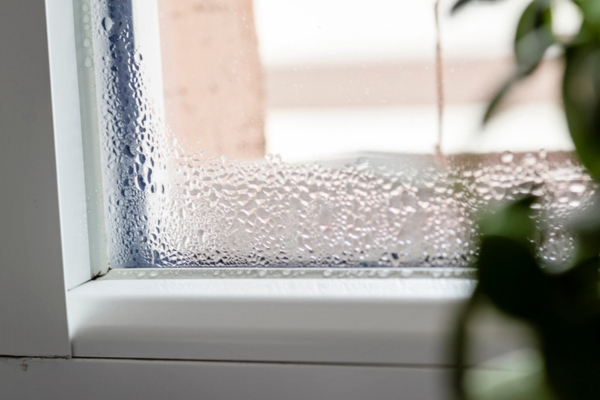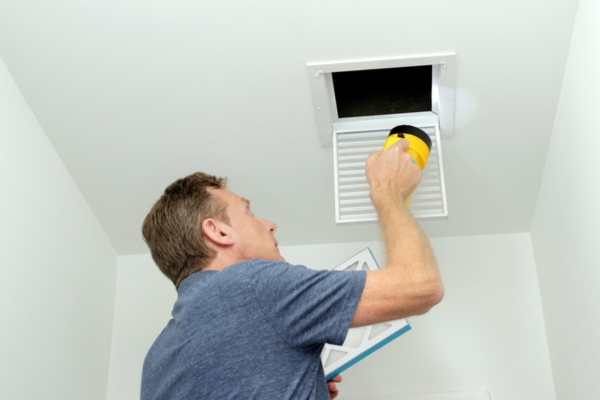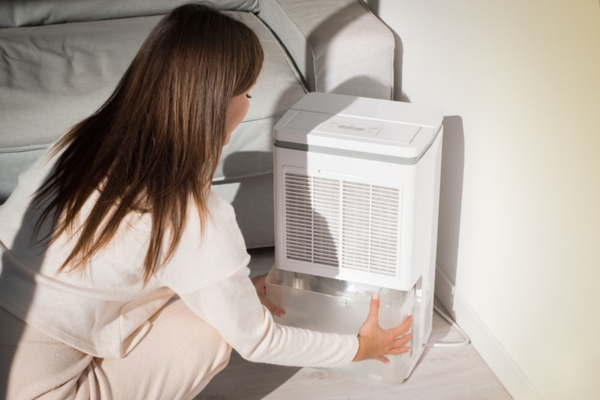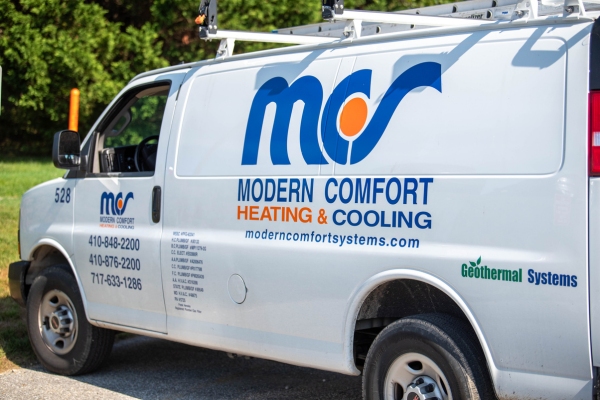Condensation in HVAC air ducts presents a significant issue, impacting the health of your HVAC system and the air quality you breathe indoors. Moisture on the vents fosters an ideal mold and mildew proliferation setting, posing potential health risks and impairing airflow.
This moisture can also harm ductwork, leading to structural issues and reduced efficiency. Grasping the reasons behind and the repercussions of air duct condensation is crucial for timely intervention, guaranteeing your HVAC system’s optimal performance and health. In this article by Modern Comfort, we discuss what you need to know about condensation in your air ducts.
The Implications of Air Duct Condensation
While the appearance of condensation on air ducts might seem troubling, it doesn’t automatically spell disaster for your HVAC system. Effective measures exist to lessen its impact and ensure the durability of your heating and cooling infrastructure. Keep reading to learn the steps that can help you tackle this concern.
Understanding Condensation

When water vapor in the air transitions to liquid form upon making contact with a cooler surface, condensation happens. This is a process seen in everyday life, such as when a cold beverage is placed in a glass during a warm day. The exterior of the glass quickly becomes covered in water droplets as the chill of the liquid inside the glass cools its outer surface. This cooling effect causes the water vapor in the warmer surrounding air to cool down and condense into liquid droplets. The root of this transformation lies in the disparity in temperature between the air and the cold surface of the glass, facilitating the change from vapor to liquid.
This same principle applies to HVAC air ducts. When cold air moves through the ductwork, the ducts themselves cool down. For instance, during the operation of your HVAC system, the interaction between the warmer ambient air and these chilled ducts leads to condensation on the surface of the ductwork.
Yet, this common scenario is not the sole reason behind condensation on your ductwork. Multiple factors can lead to such moisture issues. These will be explored in further detail later in this comprehensive article.
The Impact of Condensation on Ductwork

Condensation can negatively affect ductwork in various ways. Accumulated moisture on the ducts can cause several problems:
- Mold and Mildew Proliferation: Excess moisture provides an ideal breeding ground for mold and mildew. These fungi can quickly colonize the ductwork and spread throughout the home, deteriorating the quality of indoor air and possibly leading to health issues.
- Structural Damage: Prolonged exposure to condensation can significantly harm the ductwork. Moisture can cause corrosion, rusting, and deterioration of the ducts, compromising their structural integrity. This weakening may lead to air leaks, diminished airflow, and increased energy consumption.
- Reduced HVAC Efficiency: Condensation on ducts can obstruct the smooth flow of air. Moisture buildup can cause blockages or obstructions, impacting the effective distribution of conditioned air across the area. This may result in inconsistent cooling or heating, diminished comfort levels, and heightened energy expenditure.
- Increased Energy Costs: Compromised ductwork due to condensation forces the HVAC system to exert more effort to maintain airflow, resulting in higher energy consumption and, subsequently, increased utility expenses.
Why Condensation Forms in Air Ducts

A few factors contribute to the formation of condensation within air duct systems. Here are the primary reasons you might find moisture accumulating in your ducts:
- Temperature Difference: The main trigger for duct condensation is the temperature gap between the cool air inside the ducts and the warm, humid air outside. When warm air contacts the cooler duct surfaces, its moisture condenses into droplets.
- High Humidity: Elevated humidity levels within your home or its environment can lead to condensation on air ducts. Moisture-laden air releases this excess moisture when it hits a cooler surface, leading to condensation.
- Poor Air Duct Insulation: Insufficient insulation around air ducts can result in significant temperature discrepancies between the ducts and the ambient air. Such temperature variances are conducive to the formation of condensation on the duct surfaces.
- Air Leakage: Air leaks within the ductwork allow warm, humid air from attics, crawl spaces, or basements to infiltrate the cooler ducts. This intermingling of different air temperatures can result in condensation.
- Inadequate Air Duct Ventilation: A lack of sufficient ventilation in the duct system can obstruct airflow, accumulating stagnant air. This stagnant air is more prone to condensation, increasing the risk of moisture buildup.
- Improper Duct Installation: Poorly designed or incorrectly installed ductwork can lead to air leaks, temperature discrepancies, and consequent condensation problems.
Identifying and tackling the root causes of condensation within air ducts is crucial for averting moisture-related complications. Seeking a professional HVAC technician’s expertise can aid in pinpointing and rectifying the specific reasons behind condensation in your air duct system.
Whether you need routine maintenance or complex repairs, our team has the skills and expertise to handle it all. Call Modern Comfort today!
Preventing Condensation on HVAC Ductwork

To combat condensation on air ducts, consider implementing the following effective strategies:
Insulate the Ductwork
Ensuring your air ducts are wrapped in high-quality insulation materials boasting a high R-value is critical. Insulation preserves the duct surface’s temperature, significantly reducing the likelihood of condensation. It’s important to choose insulation that is durable and efficient.
Seal Duct Leaks
Air leaks in your ductwork can allow warm, humid air to enter, a common cause of condensation. Engaging with an HVAC contractor is recommended to inspect and seal any leaks or openings using mastic sealant or metal tape, ensuring the ductwork is airtight.
Maintain Proper Duct Ventilation
Ensuring your duct system has sufficient ventilation is crucial for promoting optimal airflow. This strategy helps prevent the buildup of stagnant air, thereby diminishing the risk of condensation. Installing appropriately sized supply and return vents is essential for sustaining effective air circulation.
Control Indoor Humidity

Implementing dehumidifiers or enhanced ventilation systems can effectively manage and lower indoor humidity levels. Keeping the humidity within the recommended range, usually between 30% and 50%, is critical in minimizing the chances of condensation forming.
Proper HVAC Sizing
Ensure that your HVAC unit is sized correctly to meet the needs of your home. Oversized and undersized units can lead to problems with condensation due to inefficient operation and poor humidity control. Consulting with an HVAC professional to assess and recommend the appropriate system size is a wise step toward preventing condensation issues.
For reliable HVAC services tailored to your needs, turn to Modern Comfort. Call us today and experience the difference for yourself!
Regular HVAC Maintenance

Ensure you schedule consistent HVAC maintenance to catch and tackle any early signs of condensation. Prompt repairs or modifications can halt the progression of the issue.
Adopting these preventive steps can greatly reduce or even stop condensation on air ducts, ensuring your HVAC operates efficiently, and your indoor air quality remains high. Consulting with an HVAC professional for more personalized advice is beneficial.
Experience the convenience of reliable HVAC services with Modern Comfort! Call us today!
Conclusion
Preventing condensation on air ducts is a realistic goal when the root causes are directly addressed. Proper duct maintenance, using whole-house dehumidifiers and humidifiers, and insulating the ducts can mitigate these issues. With a clear understanding of the causes and appropriate preventive measures, you can eliminate condensation on your air ducts, ensuring efficient, reliable cooling and improved indoor comfort.
Contact Modern Comfort for Your HVAC Needs
Modern Comfort is your go-to source for heating and cooling services in Central Maryland, and Southern and Central Pennsylvania. Our team of professionally certified technicians are experts in HVAC maintenance, repair, installation, and replacement and is committed to providing top-notch service.
We recognize the importance of a comfortable, energy-efficient home, offering competitive pricing on our services. Our maintenance services aim to enhance comfort and minimize energy costs. Our experts will guide you to the best HVAC repair or replacement solution while being mindful of your budget. With a satisfaction guarantee, we stand by the quality of our work.
Call us to book a service appointment. We offer free in-home estimates, ensuring you have all the necessary information to make the best decision for your HVAC system. Trust Modern Comfort to deliver exceptional service that exceeds your expectations!
You can click here to contact us now or call us at (410) 429-7252 (MD residents) and (717) 489-3939 (PA residents) to find out more! Click the link to view our service area.

Related Articles:
- Red Flags For Home Air Quality Problems
- Breathing Easy: Gauging the Right Amount of Home Ventilation
- Demystifying Home Air Quality: An Insightful Look at the MERV Rating
- Six Cool Advantages of Scheduling Your Air Conditioner Tune-Up
- Cutting Carbon Footprints with Advanced High-Efficiency Heating Systems

Recent Articles
